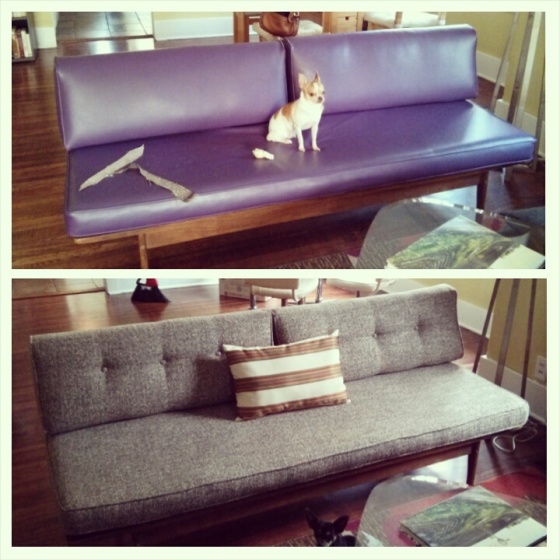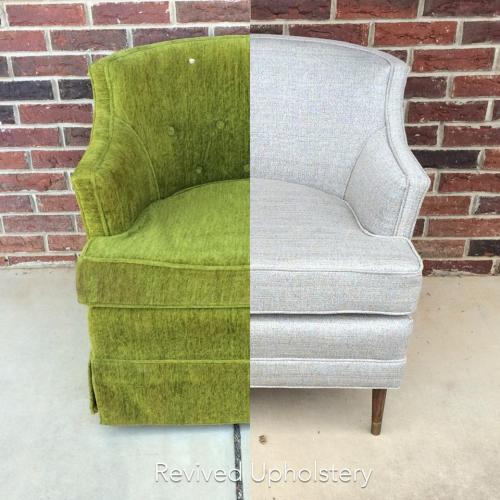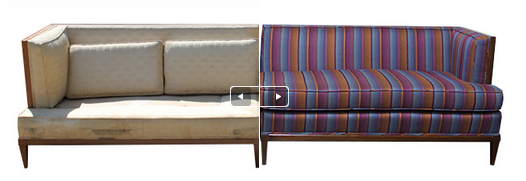If you have an obsession with interiors like I do, buying a new sofa can be an epic–even spiritual–quest. This piece of furniture must be all things to all people: comfortable enough for your husband, washable enough for your dogs, and big enough for your friends and family to sit down and stay awhile. Plus, it has to meet your own need to have a piece of furniture that’s stylish but not too trendy, fits your aesthetic sensibility, complements your color palette, and enhances your overall vision for the space. Not to mention that a sofa is a big budget purchase, and one that you want to be comfortable and look good for a number of years.
Even if you’re not a crazy couch lady, you probably still want a sofa that fits your lifestyle and makes the most of your budget, and that’s a tall enough order in itself.
We’re in the midst of selling the adorable mid-century platform sofa we had reupholstered a year ago (*wipes away a tear*) and questing for a larger, cushionier (hoping to get this added to the dictionary this year) sofa better for entertaining and lounging in front of the TV. Here’s a shot of our couch’s makeover.
By far the most popular approach to finding a new sofa is to shop in a store or online. That’s not the only approach, though. Right now we’re weighing whether to go the conventional route, or to source a vintage piece and have it reupholstered. I think there are a lot of benefits to going with a vintage option, but there are also a lot of things to consider when selecting a piece to reupholster. Here are a few tips to help you choose a great candidate for reupholstery or decide whether a piece you have is worth the investment.
1. Research Costs and Know Your Budget
Before you make the leap and buy a piece of furniture, have a realistic idea what upholstery costs are like as well as what your total budget is. This helps you know whether you have $50 or $1500 to find that perfect piece and keeps you from ending up with something you can’t actually afford to have finished. Research upholsterers in your area and get a basic idea what their pricing is like. Many start with a fee per yard of fabric needed, which can give you a good baseline for the cost. You can even get a ballpark for how much fabric a piece needs by referencing yardage charts like the one here.
Speaking of fabric, you should research the price of that, too. The cost for upholstery fabric is wide ranging–it can be anywhere from $8/yard wholesale to $100+/yd for specialty fabrics–and you want to be able to figure that cost into your total budget, too.
2. Quality, Quality, Quality
Quite simply, reupholstery isn’t cheap. That’s exactly why you want to focus on quality when selecting any piece of furniture. Not all furniture from mass retailers is cheaply made, but I do think you should think carefully before sinking money into redoing a Sofa Mart accent chair. If the furniture frame is plywood held together with staples and glue, it’s going to wear out when it wears out, regardless of how nice and crisp the fabric is. For the quality and price, you’re better off getting something with a new frame, too.
Maybe I’m biased, but I do think vintage furniture is a better candidate for reupholstery right out of the gate. That being said, old doesn’t necessarily mean good. Take a piece of furniture for a test run before you make any decisions. It’s usually pretty easy to tell when a piece of furniture is well made. If it’s heavy and the frame is stable, it probably passes our first criterion.
3. Condition Makes a Difference
Damaged or broken furniture may still be a good candidate for reupholstery, but be aware that repairing or replacing things comes with a price tag. Check the condition of whatever elements of the piece you can, especially the cushion foam. Replacing foam that has hardened or crumbled over time sharply increases the cost of a reupholstery project. The lifespan of high quality foam is only about 20 years, so if the cushioning in a vintage sofa is original, there’s a good chance it’s time for a refresh.
The good news is, sometimes previous owners have already replaced the cushions. Unzip the covers and visually inspect the foam if you can. If it’s newer, that’s a huge bonus; if not, let your upholsterer know (he or she will probably ask anyway) so you can get an accurate estimate.
4. Choose a Shape with Lasting Appeal
You may love your reupholstered sofa so much that you keep it forever and hand it down to posterity. Or you may change your decor in a couple years and trade it in for something different. Either way, reupholstery is an investment, and you want to invest in something that will retain its value and appeal over time. Choosing a classic shape or style will help your piece remain desirable, whatever you decide to do with it.
5. Use your Imagination!
Reupholstery can be more than just recovering a piece of furniture. It can also include changes to the style of the piece that can make for a stunning transformation. For example, lots of vintage sofas and chairs have skirting that looks dated to us today, but those can easily be removed. I’m constantly looking up the skirts of sofas in flea markets to check out their legs (thrift shopping never sounded so risque!). This chair by the super-talented Revived Upholstery is a great example of how a piece can be reimagined. With the skirt removed and the back detail simplified, the chair looks much more modern.
Another inspirational example is the fab couch below reupholstered at the Austin-based firm Spruce. The jazzy striped fabric helps, but replacing the cushions with a fixed back makes the overall silhouette tons more streamlined.
Thinking about furniture in this way will help open your eyes to pieces with potential that you otherwise may have overlooked and make getting your dream sofa even more satisfying.
For more inspirational makeovers from the upholsterers featured above, check out Revived Furniture Gallery and Upholstery on Facebook here, or visit Spruce’s website here.



